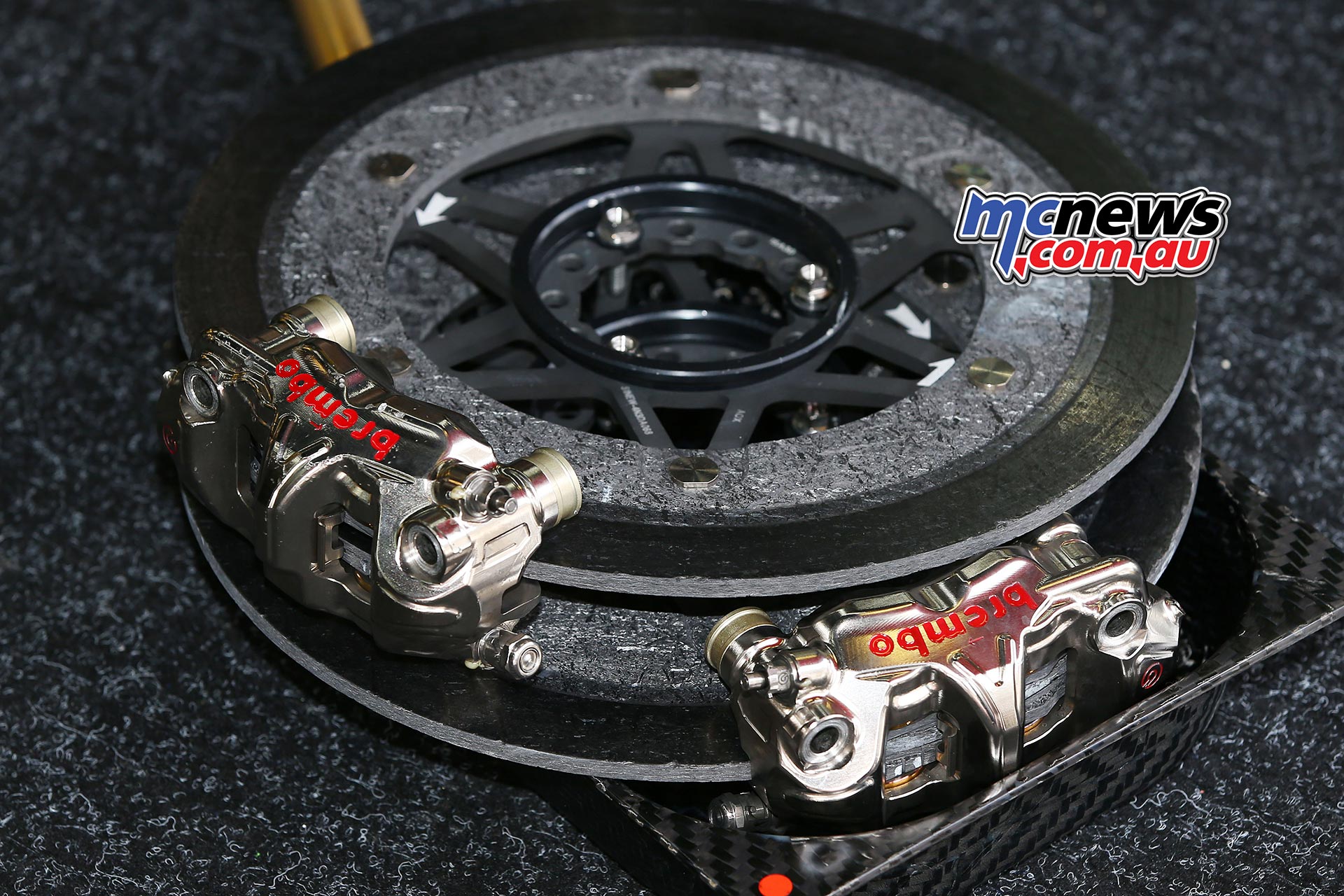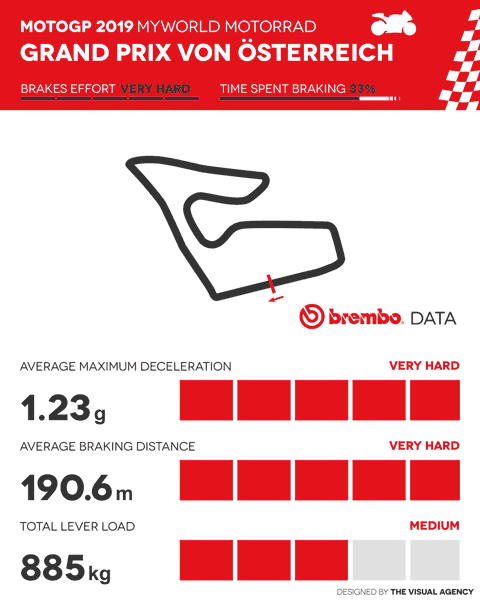MotoGP v F1 at the Red Bull Ring
Brembo braking data
Six weeks after having hosted Formula 1, the Red Bull Ring in Spielberg (Austria) will this weekend play host to the 11th appointment of the MotoGP season.
The many undulations of the track complicate the riders’ choice of timing braking: there’s a 65 metre (213 feet) difference between the highest and the lowest point, and the steepest slope has a 9.3 percent incline.
According to Brembo technicians, who equip the entire MotoGP grid, the Red Bull Ring is very demanding on the brakes. On a scale of 1 to 5, it earns a 5 on the difficulty index, the same score given to the tracks in Barcelona, Motegi and Sepang. Our home track at Phillip Island is the least demanding circuit on the MotoGP circuit when it comes to brakes.
On one full lap, the MotoGP riders use their brakes 7 times for a total of 28 seconds.
Formula 1 cars also brake 7 times in each lap, but for a third of the time, totalling just 9.8 seconds.
Over the 28 race laps at Spielberg each MotoGP bike uses its brakes for some 800 seconds, that’s just over 13 minutes.
Last month, on the other hand, the winner of the Formula 1 GP completed the 71 laps of the Austria GP, two and a half times the race distance, using Brembo calipers for just 10 minutes and a half.

Average deceleration per lap for the MotoGP is 1.23 g, which is second highest value of the championship. Summing up all of the forces applied by a rider on the Brembo brake lever from the starting line to the chequered flag, the result is about 0.9 tonnes.
The most challenging section is Turn One, since it is located at the fastest point on the track, despite being slightly uphill: the MotoGP bikes reach the bend at 312 km/h (193.9 mph) and then brake for 4.4 seconds to slow to 99 km/h (61.5 mph). Riders put 5.9 kg (13 lbs) pressure on the brake lever and are subjected to a 1.5 g deceleration.
Formula 1 single-seaters reach this same section at a slightly higher speed (331 km/h, 205.7 mph), but are able to enter the turn at 158 km/h (98.2 mph) and, most importantly, can slam on the brakes without fear of the rear end rising in the air: thus braking only lasts 1.57 seconds and 99 metres (325 feet), less than half the distance (229 meters, 751 feet) required by the MotoGP bikes.
The braking time and distance are even greater for Turn Four, partly due to the downhill slope: 274 metres (899 feet) and 5.7 seconds to come down from 292 km/h (181 mph) to 85 km/h (53 mph). Here deceleration is 1.4 g, while for Formula 1 drivers it gets up to 5.2 g. The pressure of the Brembo HTC 64T brake fluid in the MotoGP bikes climbs to 11.9 bar (173 psi), while it peaks at 12.6 bar (183 psi) for the Castrol Edge in the F1 cars.
Turn Three is the slowest on the track with a speed of 64 km/h (40 mph) on entry. Riders clamp on their brakes for 5.5 seconds putting a 5.1 kg (11.2 lbs) load on the lever. The comparison with the four wheelers is less stark since the F1 brakes are used for 2.59 seconds to drop to 84 km/h (52 mph) after braking.
The F1 qualifying record at Red Bull Ring is 1m03.003-seconds. That time is more than 20-seconds faster than the MotoGP qualifying lap record set by Andrea Iannone in 2018 at 1m23.142s. The MotoGP race lap record is currently held by Andrea Dovizioso at 1m24.277s.

F1 Braking Data – Red Bull Ring
| Time | Class | Session |
| 1700 | Moto3 | FP1 |
| 1755 | MotoGP | FP1 |
| 1855 | Moto2 | FP1 |
| 1950 | MotoE | FP1 |
| 2115 | Moto3 | FP2 |
| 2210 | MotoGP | FP2 |
| 2310 | Moto2 | FP2 |
| 0050 (Sat) | MotoE | FP2 |
| Time | Class | Session |
| 1630 | MotoE | FP3 |
| 1700 | Moto3 | FP3 |
| 1755 | MotoGP | FP3 |
| 1855 | Moto2 | FP3 |
| 2035 | Moto3 | Q1 |
| 2100 | Moto3 | Q2 |
| 2130 | MotoGP | FP4 |
| 2210 | MotoGP | Q1 |
| 2235 | MotoGP | Q2 |
| 2305 | Moto2 | Q1 |
| 2330 | Moto2 | Q2 |
| 0000 | MotoE | E-Pole |
| Time | Class | Session |
| 1620 | Moto3 | WUP |
| 1650 | Moto2 | WUP |
| 1720 | MotoGP | WUP |
| 1800 | MotoE | Race |
| 1900 | Moto3 | Race |
| 2020 | Moto2 | Race |
| 2200 | MotoGP | Race |























